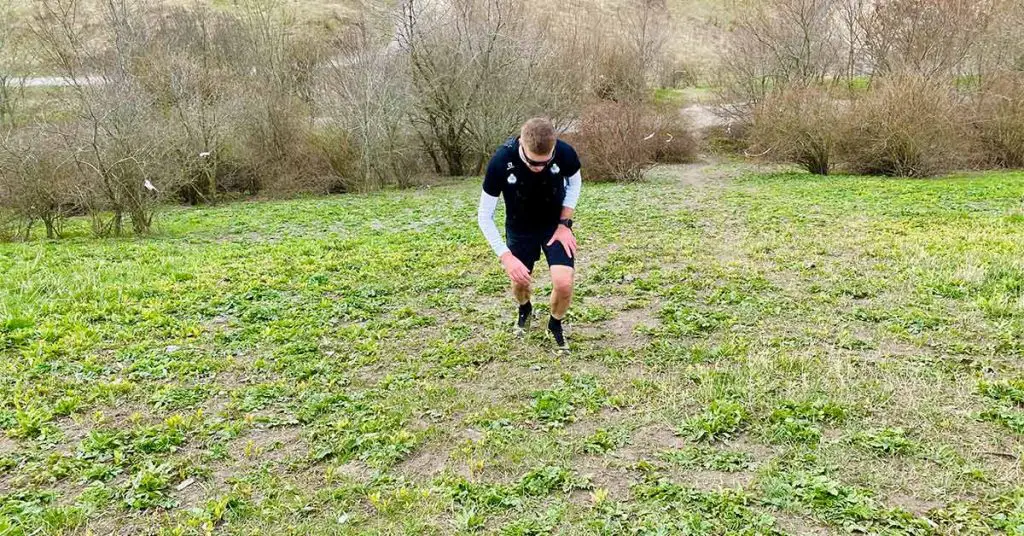Estimated read time: 9 minutes.
Trail running is a thrilling sport that allows you to explore the great outdoors while pushing your physical limits. However, learning how to increase trail running distance without injury is a challenge many runners face. In this blog post, we’ll guide you through essential strategies and techniques to safely improve your trail running performance while minimizing the risk of injury. Get ready to conquer those trails with confidence!
Key Takeaways
- Stay consistent with training and incorporate cross-training activities for a strong foundation.
- Set realistic goals, gradually increase intensity & volume over time, use the 10% rule to safely build mileage.
- Listen to your body while prioritizing recovery & maintenance for injury prevention and progress!
Building a Strong Foundation for Trail Running
Establishing a strong foundation for trail running is a necessary step before tackling longer distances. A solid base helps prevent injuries and improves your overall performance as you gradually increase your weekly mileage. The key is to stay consistent with your training and incorporate cross-training activities and muscle strengthening exercises into your training plan.
Maintaining consistency allows your body to adapt to the demands of running and prevent overuse injuries. Whether you’re a beginner or an experienced runner, creating consistent running habits, engaging in cross-training activities, and performing muscle strengthening exercises will provide you with the foundation necessary to safely increase your trail running distance.
Consistent Running Habits
A surefire way to increase your trail running distance without injury setbacks is to establish consistent running habits. As a beginner, it is recommended to run 2-3 days per week for maximum benefit and to increase mileage safely. Experienced runners can enjoy running up to 4 days per week for optimal results, gradually increasing their mileage over a few weeks.
Maintaining consistency in your running schedule stimulates muscle fiber growth, improves aerobic development and economy, and enhances force production rate. These factors contribute to building strength and a solid aerobic base, giving you the edge you need to reach your trail running goals.
Cross-Training Activities
You can significantly boost your overall fitness and reduce the risk of injury by incorporating cross-training activities into your trail running training plan. Resistance training exercises like push-ups, pull-ups, squats, lunges, and planks are great for building strength. Cycling, swimming, and strength training are other excellent cross-training activities for trail runners.
Motivate yourself to incorporate cross-training by initially adding one or two activities per week and increasing the frequency and intensity gradually as needed. Remember to listen to your body and adjust the intensity and frequency of the activities accordingly for the best results while considering your total miles per week.
Muscle Strengthening Exercises
Strengthening key muscle groups, such as the glutes, core, and hips, can help prevent injuries and improve trail running performance. Aim for twice a week of strength training to reap the benefits.
Weakness in the hips and glutes is often the culprit of knee, ankle, or hip pain. Incorporating muscle strengthening exercises into your training program can help build endurance and increase your running distance, giving you the boost you need to reach your goals.
Tailoring Your Training Plan
For injury-free progress in trail running, create a training plan that meets your individual needs and goals. Factors to consider include setting realistic goals, balancing intensity and volume, and adjusting your training plans as needed.
A personalized training plan ensures you push yourself to reach your goals without overworking your body. This approach helps you strike the right balance between challenging yourself and staying injury-free, making it an ideal new training program.
Setting Realistic Goals
Prevent overtraining and injury by setting realistic goals for increasing your trail running distance. Consider your current fitness level, the amount of time and effort you can dedicate to training, and the type of terrain you will be running on when setting your goals.
The gradual process of increasing mileage is key to staying motivated and reaching your goals. By focusing on getting more mileage and tracking your running mileage, strategies such as the 10% rule, building for three weeks and resting for a week, and alternating distance and intensity can help you achieve a sustainable increase in trail running distance.
Balancing Intensity and Volume
The ideal balance between intensity and volume in a trail running training plan leads to optimal performance and injury prevention. Gradually increase both volume and intensity over time to stay energized and reduce the risk of injury. Breaking up your training plan into different phases, such as base building, strength training, and tapering, can help you adapt the volume and intensity of your workouts based on the specific objectives of each phase.
Pay attention to your body’s response to training. If you’re feeling tired or enduring persistent soreness, it may be a sign that you need to adjust the balance between intensity and volume. Include cross-training activities to supplement your trail running workouts, improving overall fitness and reducing the risk of overuse injuries.
Adjusting Training Plans
Continuous improvement and injury prevention require fine-tuning of your trail running training plan. Factors to consider when adjusting your plan include:
- Maximizing elevation gain
- Efficiently managing effort
- Taking into account your individual fitness level
- Structuring time and effort-based training
As you progress in your training, be prepared to make adjustments based on your performance, fitness level, or race goals. This adaptability will allow you to continue making progress while reducing the risk of injury.
Gradual Mileage Increase Strategies
To prevent injuries while increasing trail running distance, apply gradual mileage increase strategies for runners. Runners increase mileage by following the 10% rule, building for three weeks and resting for a week, and alternating distance and intensity, which are popular and effective strategies to increase mileage safely and effectively.
Implementing these strategies ensures a steady increase in your trail running distance without overloading your body and risking injury. Remember, the real key to increasing running distance is being in tune with your body and taking rest when necessary.
The 10% Rule
The 10% rule, a popular strategy, facilitates a gradual increase in weekly running mileage without injury. It suggests that you should not increase your weekly mileage by more than 10% from one week to the next, allowing your body to adjust. This approach helps minimize the risk of overuse injuries and fatigue, enabling you to progress at a safe and sustainable pace.
As you build your running distance, consistently practicing the 10% rule is vital. This will not only help you avoid injury but also ensure that you’re making steady progress towards your trail running goals.
Build for Three Weeks, Rest for a Week
Another effective method for gradually increasing your mileage while giving your body the rest it needs is the “build for three weeks, rest for a week” strategy. By increasing your mileage for three consecutive weeks followed by a reduction in the fourth week, you allow your body to recover and adapt to the increased workload.
This strategy helps maximize performance gains while minimizing the risk of injury. By incorporating a rest week into your training plan, you give your body the opportunity to repair and rebuild, leading to improved performance and injury prevention.
Alternate Distance and Intensity
Prevent overtraining and injury while increasing trail running distance by alternating between distance and intensity in training sessions. Varying the length and intensity of your runs can improve your endurance, speed, and overall performance. Incorporating speed workouts into your routine can further enhance these benefits.
To implement this strategy, consider:
- Having shorter sessions during the week
- Having a longer run on the weekend
- Incorporating speed or interval workouts three to four times a week to challenge your body and enhance your trail running performance
- Listening to your body and gradually increasing the intensity and distance over time to avoid injury.
Trail-Specific Techniques for Injury Prevention
Mastering trail-specific techniques, in addition to building a strong foundation and tailoring your training plan, can significantly reduce your risk of injury on the trails. Proper footwear, uphill and downhill running techniques, and adapting to varied terrain are essential components of injury prevention in trail running.
By incorporating these trail-specific techniques into your training, you can confidently tackle any trail while minimizing the risk of injury. Let’s explore these techniques in more detail.
Proper Footwear
The right footwear for trail running can make a significant difference in preventing injuries and enhancing your performance. Trail running shoes are designed with rugged soles for superior grip, increased stability to stop your foot from rotating, and cushioning to absorb shocks.
Selecting the appropriate trail running shoes for the terrain you’ll be running on is crucial. For more rugged and uneven terrain, opt for shoes with deeper lugs and more aggressive outsoles, while smoother and less technical terrain requires shoes with shorter lugs and less aggressive outsoles.
Replacing your trail running shoes every 300-500 miles or every 4-6 months ensures optimal support while trail running.
Uphill and Downhill Running Techniques
Proper uphill and downhill running techniques, when practiced, reduce the risk of injury and improve efficiency on the trails. When running uphill, maintain a consistent pace, take shorter strides, lean slightly forward, and use your arms to help you power up the hill. On downhill sections, use a longer stride, lean back slightly, and use your arms to support your balance and regulate your speed.
Mastering these techniques takes practice and patience. Gradually increase your speed and distance while maintaining proper form to hone your balance and strength during uphill and downhill running.
Adapting to Varied Terrain
For most runners, adapting their running form and pace to different terrains, such as sand, mud, grass, and rocky paths, can help prevent injuries and enhance their trail running performance.
When running on rocky terrain, take shorter strides and be mindful of the placement of your feet. On softer terrain, take longer strides while maintaining awareness of foot placement. By adjusting your form and pace based on the terrain, you can confidently navigate any trail and reduce the risk of injury.
Recovery and Maintenance
More than just a solid training plan and proper techniques, recovery and maintenance are crucial for injury-free progress in trail running, ensuring your body stays healthy and strong. Prioritizing sleep and nutrition, stretching and foam rolling, and listening to your body are key components of maintaining your trail running performance.
Focusing on recovery and maintenance minimizes the injury risk and ensures steady progress in your trail running journey with the guidance of a running coach.
Prioritizing Sleep and Nutrition
Adequate sleep and proper nutrition support your body’s recovery and repair processes, thus reducing the risk of injury. Aim for 7 to 9 hours of sleep per night to facilitate optimal performance.
Your body also requires proper fuel to recover and stay strong for endurance exercise. Focus on consuming whole grains, fresh produce, and healthy proteins and fats to provide the necessary nutrients to power your increased mileage.
Stretching and Foam Rolling
Maintaining flexibility and preventing muscle imbalances that may lead to injury can be achieved through regular stretching and foam rolling. Stretching and foam rolling a few times a week, pre- and post-workout, can help release muscle tension, alleviate soreness, and improve range of motion.
Incorporating these recovery techniques into your trail running routine can contribute to injury prevention and optimize your performance on the trails.
Listening to Your Body
Preventing overtraining and injury while increasing trail running distance requires listening to your body and adjusting your training plans accordingly. Pay attention to signs of fatigue, persistent soreness, or decreased performance, as they may indicate the need for adjustments in your training plan.
By staying in tune with your body, you can continue to make progress while minimizing the risk of injury.
Summary
Increasing trail running distance without injury is a challenge, but with the right approach, it’s achievable. By building a strong foundation, tailoring your training plan, employing gradual mileage increase strategies, mastering trail-specific techniques, and focusing on recovery and maintenance, you can conquer the trails with confidence and minimize the risk of injury. Now lace up those trail running shoes and hit the trails!
Frequently Asked Questions
How can I increase my running distance without injury?
To increase running distance without injury, start slow and increase your mileage by no more than 10% weekly. Also, listen to your body, take days off in between runs, choose varied terrain, get good shoes and cross-train when possible. This gradual progression will help build endurance and avoid overuse injuries.
How often should I replace my trail running shoes?
Keep your feet protected and supported by replacing your trail running shoes every 4-6 months or after every 300-500 miles.
What is the 10% rule for increasing running distance?
Stick to the 10% rule when increasing your running distance – this will ensure that your body can adjust gradually and reduce the risk of injury.
How can I improve my uphill and downhill running techniques?
Improve your uphill and downhill running techniques by leaning slightly forward with shorter strides when running uphill, and leaning back slightly with longer strides and using your arms for balance and power when running downhill.
How often should I incorporate cross-training activities into my trail running routine?
Cross-training should be a regular part of your trail running routine, gradually adding one or two activities per week.
- How Many Laps Around a Track is a 5K: Your Guide - October 22, 2023
- When is Track and Field Season? - October 22, 2023
- Understanding the Length: How Long Is a Running Track? - October 22, 2023



